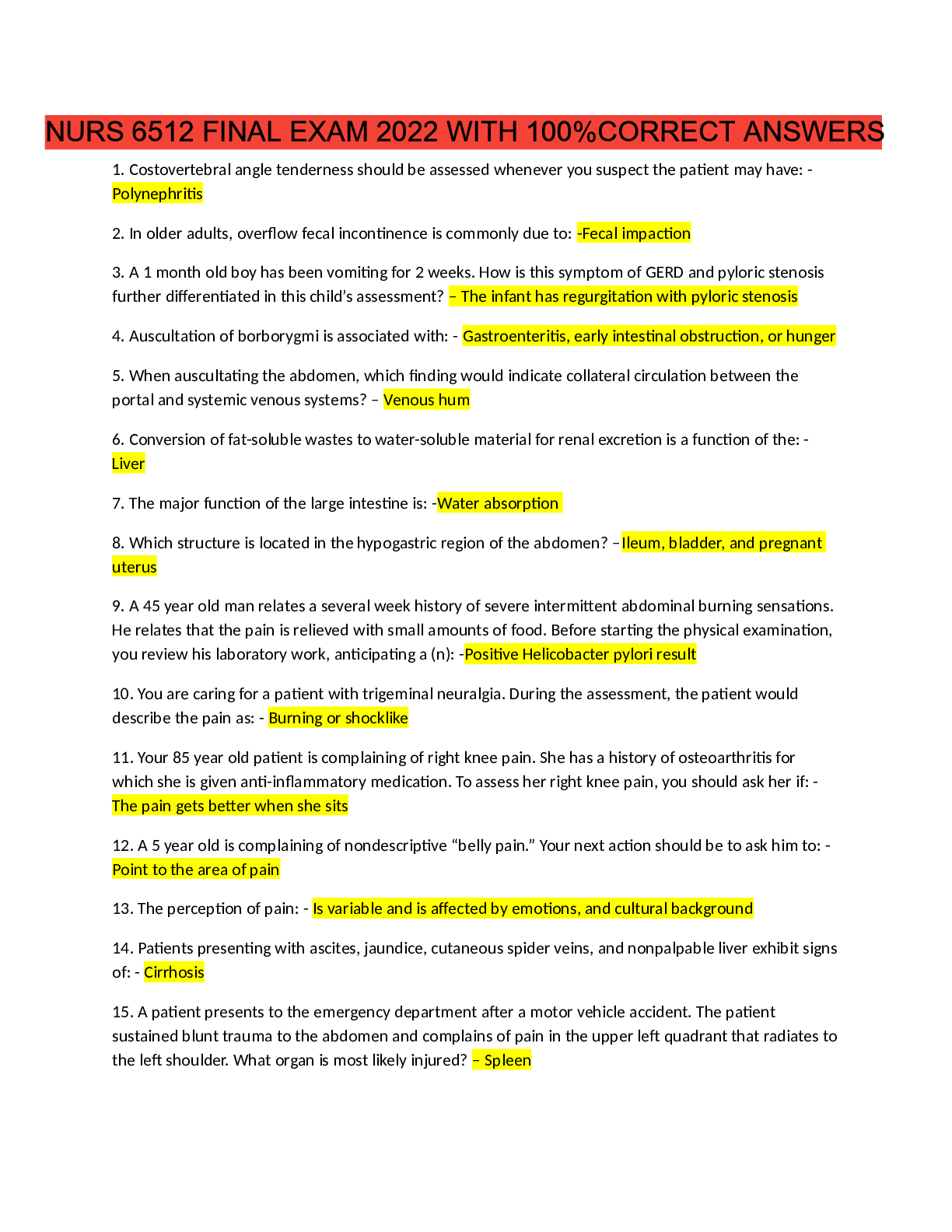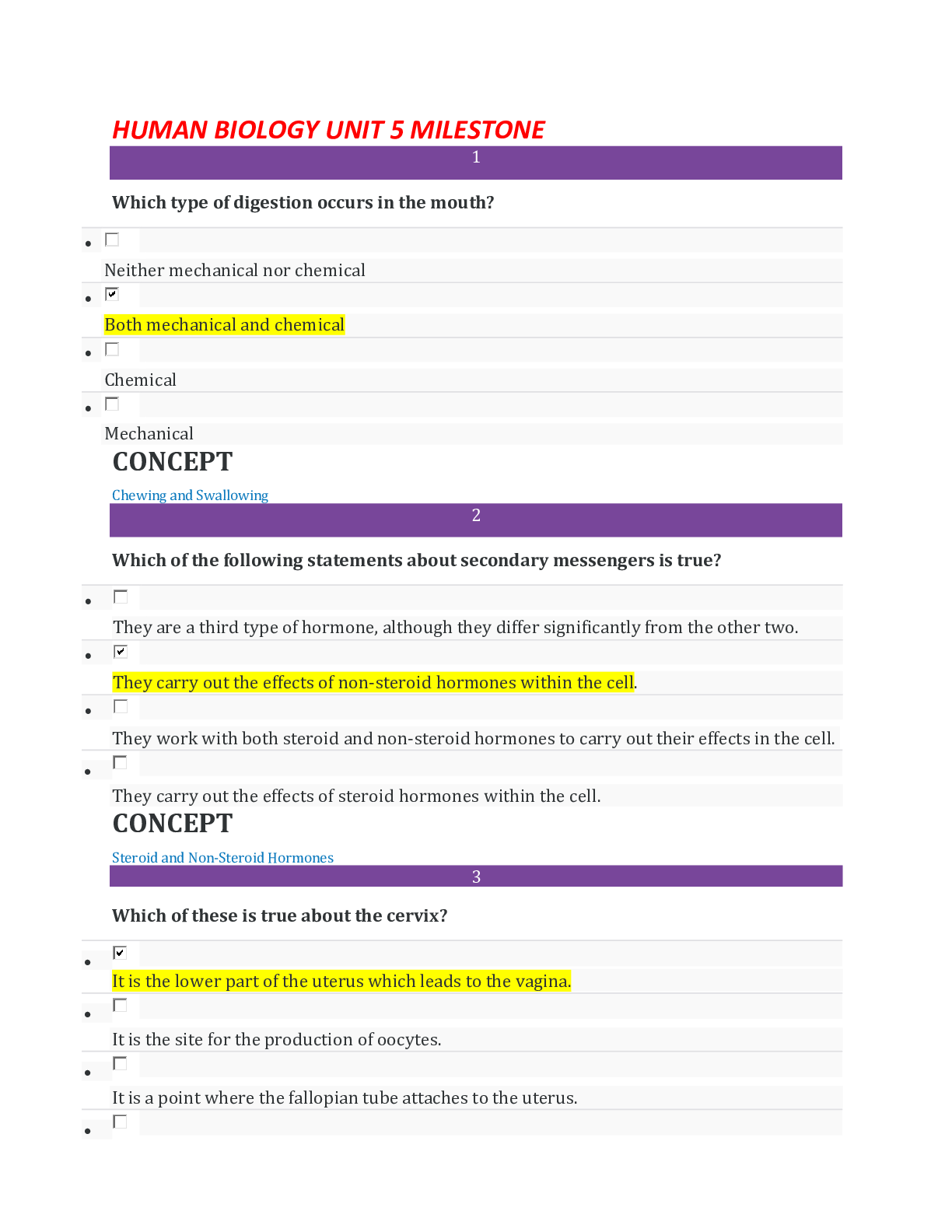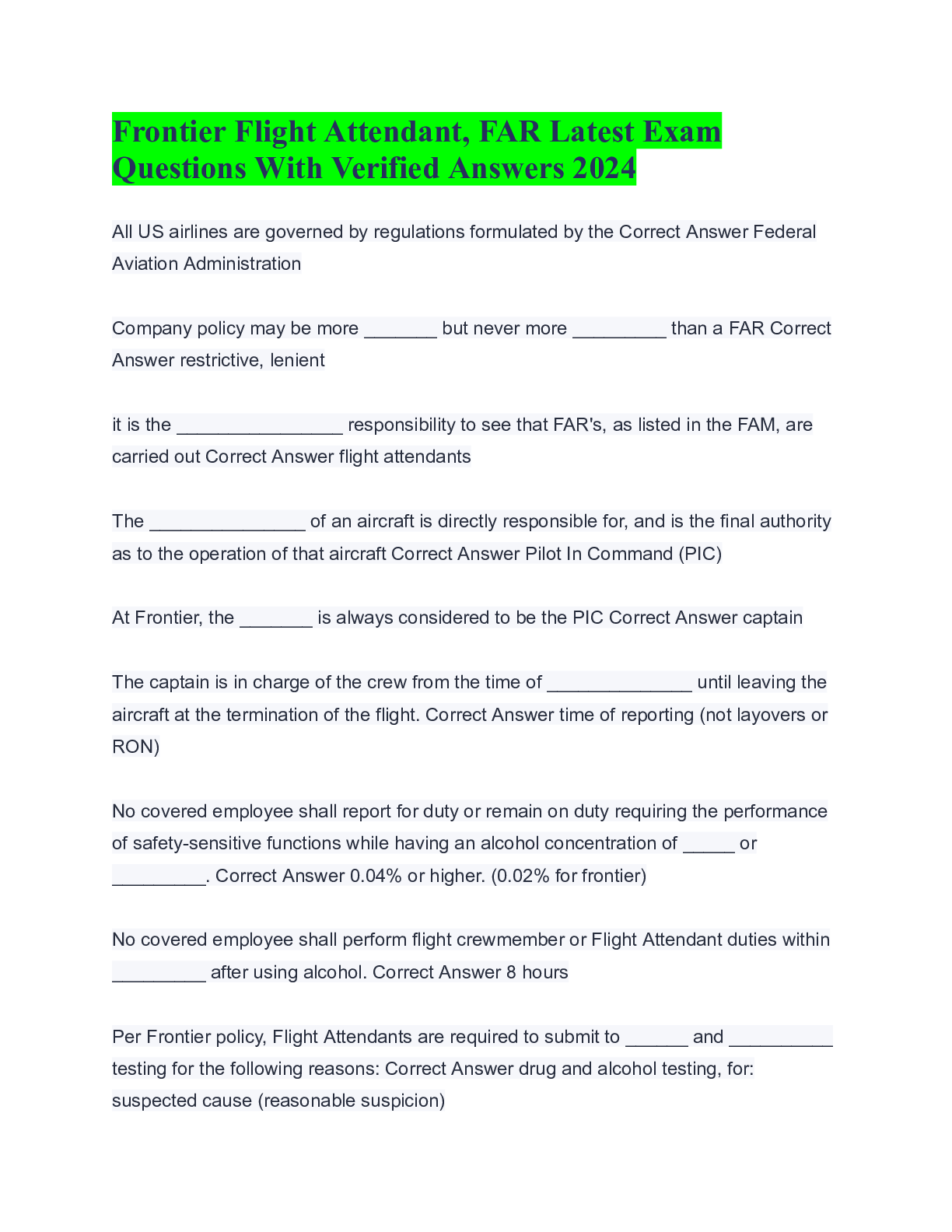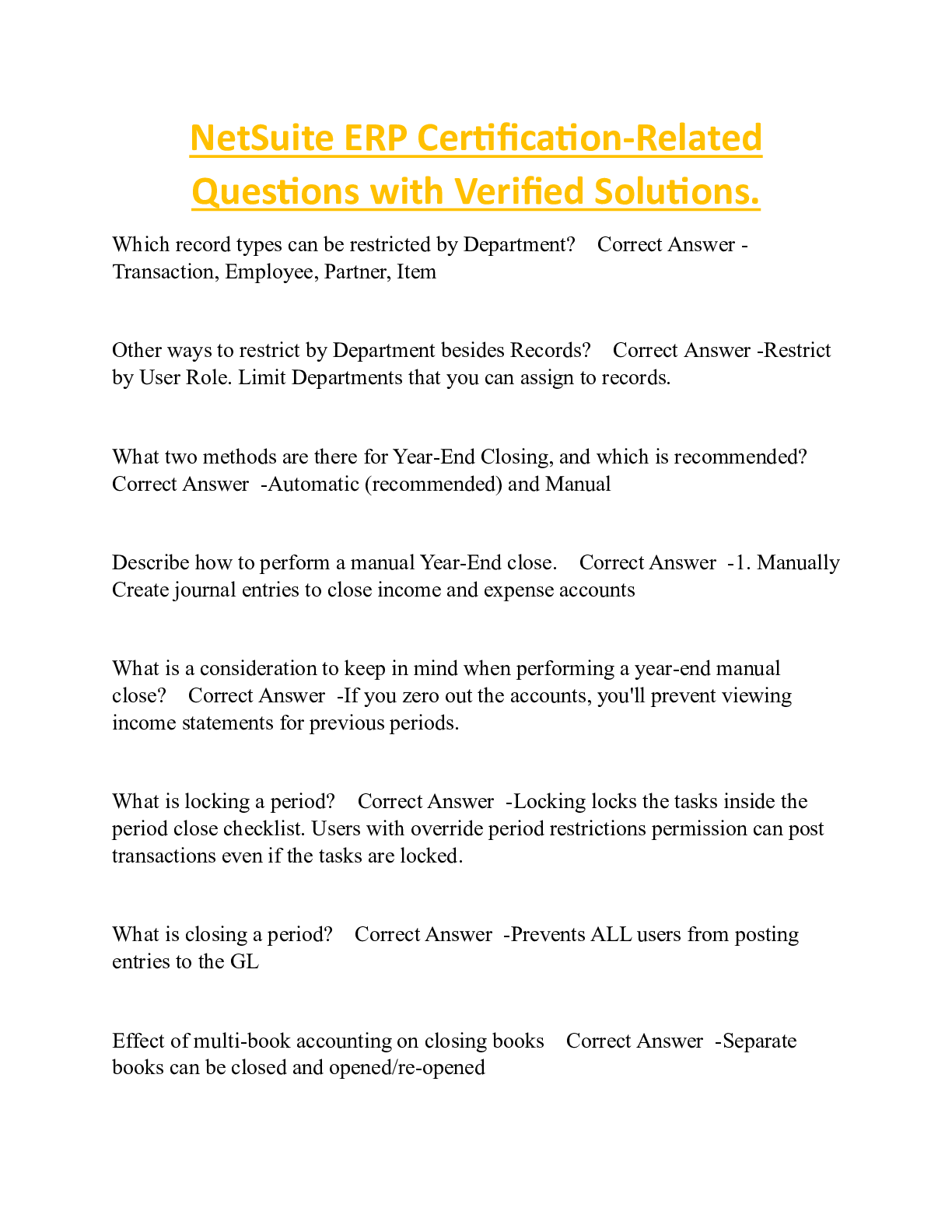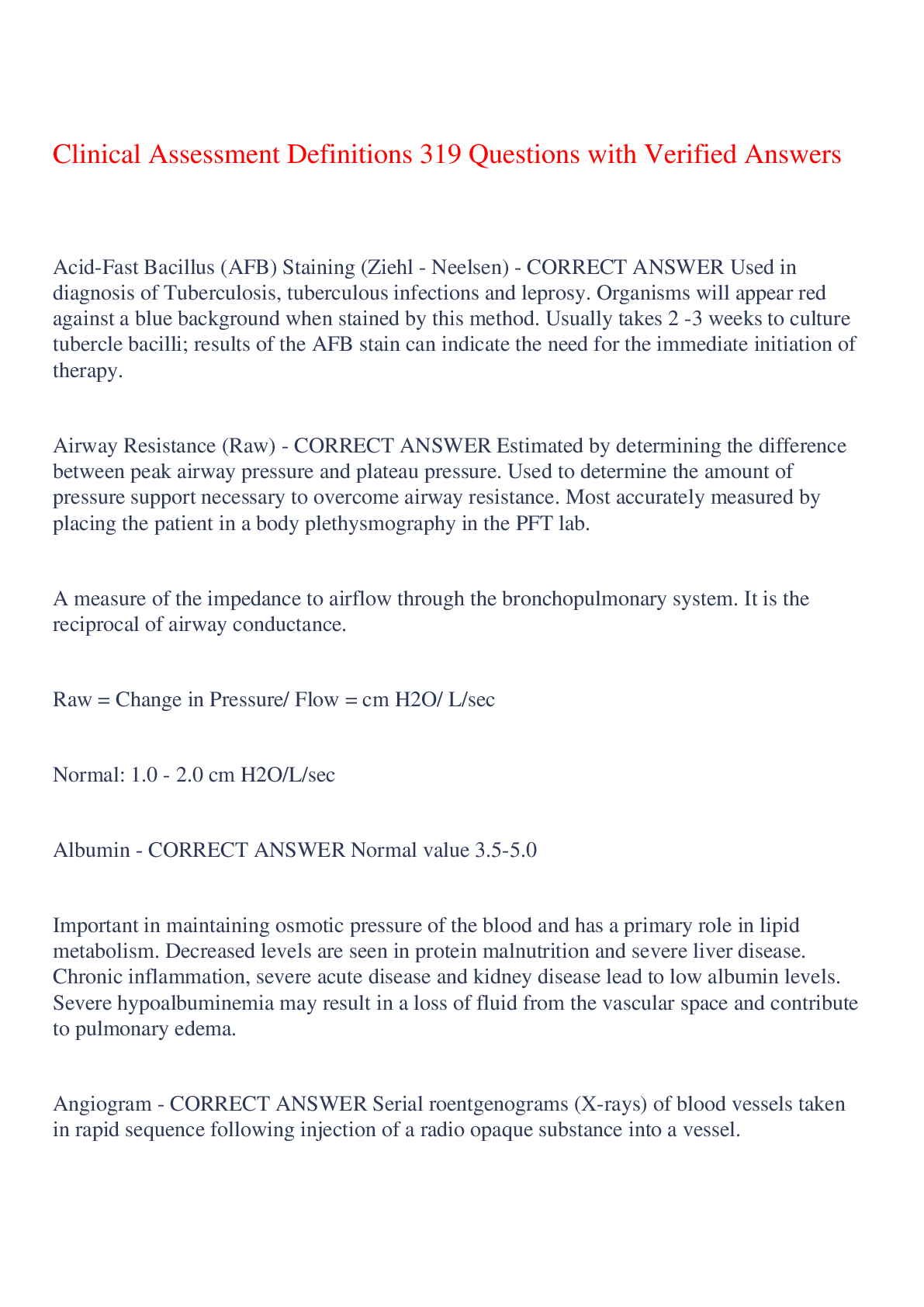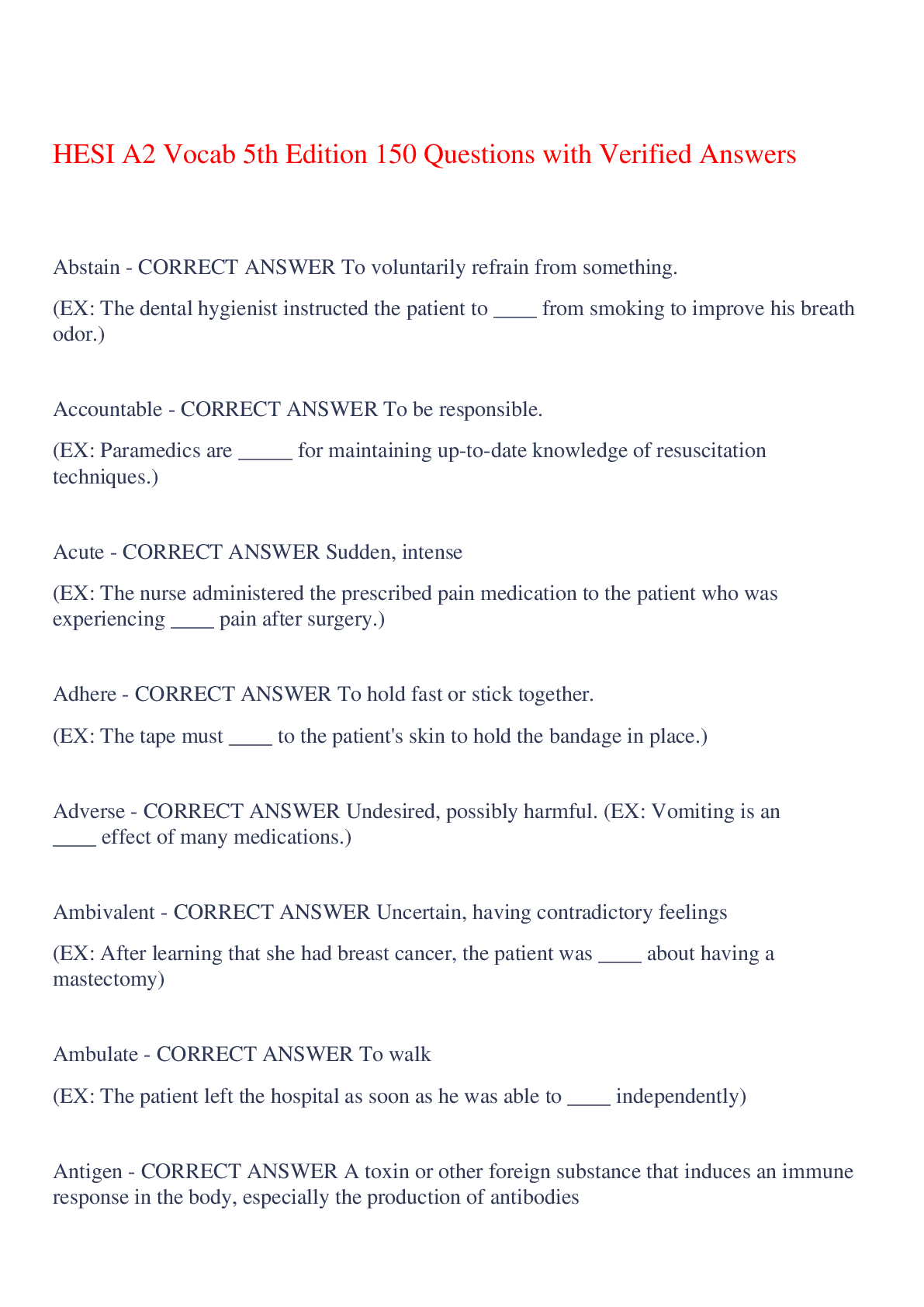*NURSING > EXAM > Nursing entrance exam anatomy 93 Questions with Verified Answers,100% CORRECT (All)
Nursing entrance exam anatomy 93 Questions with Verified Answers,100% CORRECT
Document Content and Description Below
Nursing entrance exam anatomy 93 Questions with Verified Answers median plane - CORRECT ANSWER Is a sagittal section. (sagitt = arrow) coronal plane - CORRECT ANSWER is an frontal section. (fron... = forehead; frontal bone) transverse plane - CORRECT ANSWER Is a cross-section. (trans = across) anatomic position - CORRECT ANSWER The body is erect, the feet are slightly apart, the head is held high, and the palms of the hands are facing forward. superior - CORRECT ANSWER above inferior - CORRECT ANSWER below anterior - CORRECT ANSWER facing forward posterior - CORRECT ANSWER toward the back medial - CORRECT ANSWER toward the midline lateral - CORRECT ANSWER away from the midline or toward the sides proximal - CORRECT ANSWER closer to the point of attachment distal - CORRECT ANSWER further away from the point of attachment. dorsal cavity (dors = back) - CORRECT ANSWER includes the cranial and spinal cavities. ventral cavity - CORRECT ANSWER includes the orbits and the nasal, oral, thoracic, and abdominopelvic cavities. (ventr = belly) Histology - CORRECT ANSWER is the study of tissues. tissue - CORRECT ANSWER is a group of cells that act together to perform specific functions. epithelial tissue - CORRECT ANSWER cover, line, and protect the body and its organs. connective tissue - CORRECT ANSWER is the framework of the body, providing support and structure for the organs. nerve tissues - CORRECT ANSWER is composed of neurons and connective tissue cells that are referred to as neuroglia. Muscle tissue - CORRECT ANSWER Have the ability to contract or shorten. Is classified as voluntary muscle (skeletal muscles) or involuntary muscle (smooth muscle and cardiac muscle tissue) cell - CORRECT ANSWER is the basic unit of life and the building block of tissues and organs. Each organelle has a specific function. nucleus - CORRECT ANSWER which contains deoxyribonucleic acid (DNA), and ribosomes are especially important in the synthesis of proteins. protein - CORRECT ANSWER includes the enzymes that regulate all chemical reactions within the body. Mitosis - CORRECT ANSWER Is necessary for growth and repair. In this process, the DNA is duplicated and distributed evenly to two daughter cells. Meiosis - CORRECT ANSWER Is the special cell division that takes place in the gonads, that is the ovaries and testes. The chromosome number is reduced from 46 to 23, so when the egg and the sperm unite in fertilization the zygote will have the correct number of chromosomes. Skin - CORRECT ANSWER The largest organ of the body. Consist of two layer: the epidermis and dermis. (also the hypodermis) Epidermis - CORRECT ANSWER The outermost protective layer of dead keratinized epithelial cells. Where mitosis occurs. Dermis - CORRECT ANSWER The underlying layer of connective tissue with blood vessels, nerve ending, hair follicles, glands and the associated skin structures. Rest in the subcutaneous tissue that connect the skin to the superficial muscles. Stratum corneum (corn = horn) - CORRECT ANSWER Outermost layer of epidermis Stratum lucidum - CORRECT ANSWER 2nd layer of epidermis Stratum granulosum - CORRECT ANSWER 3rd layer of epidermis Stratum germinativum - CORRECT ANSWER Innermost layer of epidermis (includes stratum basale and stratum spinosum).(Spin = thorn or spine) Eccrine gland (sweat gland) - CORRECT ANSWER The most widely distributed sweat glands regulate body temperature by releasing a watery secretion that evaporates from the surface of the skin. Apocrine gland (sweat gland) (apo = meaning away from) - CORRECT ANSWER Mainly in the armpits and groin area, display secretion contains bits of cytoplasm from the secreting cells. This cell debris attracts bacteria, and the presence of the bacteria on the skin results in body odor. Melanin - CORRECT ANSWER Protein pigment in epidermal cell. Which protects against radiation from the sun. Sebaceous gland (oil gland) - CORRECT ANSWER Release oily secretion (sebum) through the hair follicles that lubricates the skin and prevents drying. Holocrine (oil gland) (hol = whole) - CORRECT ANSWER Oil is produced by this gland, in which whole cells of the gland are part of the secretion. Keratin - CORRECT ANSWER A strong protein found in hair and nails. HESI hint 1 - CORRECT ANSWER As the epidermal cells move from the deepest layer to the superficial layers, they move away from their blood and nutrient supply; they dehydrate and die. Skeletal system - CORRECT ANSWER Functions includes support, movement, blood cell formation, protection of internal organs, detoxification (removal of poisons), provision (the action of providing) for muscle attachment, and mineral storage (particularly calcium and phosphorus). Hemopoiesis - CORRECT ANSWER Blood cell formation 5 classified bones - CORRECT ANSWER Long bones, short bones, flat bones, irregular bones, and sesamoid bones. Long bone - CORRECT ANSWER Has an irregular epiphysis at each end, composed mainly of spongy (cancellous) bone, and a shaft or diaphysis, composed mainly of compact bone. (epi = upon) (dia = across, between) (physis = a growth) Osteoblasts (ost = bone) - CORRECT ANSWER The cells that forms compact bone; when they become fixed in the dense bone matrix, they stop dividing but continue to maintain bone tissue as osteocytes (mature bone cells). (cyt = cell) Axial skeleton (axis) - CORRECT ANSWER Includes: 12 ribs, 28 skull bones, 33 vertebral column bones, and thorax. facial bones - CORRECT ANSWER There are 14 bones: 2 nasal, 2 maxillary, 2 zygomatic, 1 mandible, 2 palatine, 1 vomer, 2 lacrimal, and 2 inferior nasal conchae. (zyg = union, pair); (man = hand; movable); (palat = roof of the mouth); (vom = cutting blade of and plow); (lacrim = tear) cranium bones - CORRECT ANSWER There are 14 bones: occipital, frontal, ethmoid, sphenoid, 2 parietal, 2 temporal, 2 ossicles of the ear (malleus, incus, and stapes). (occipi = the back of the head); ethm = sieve); (os = bone) vertebral column bones - CORRECT ANSWER There are 33 bones: 7 cervical vert. ( includes the axis vert., and atlas vert.), 12 thoracic vert., 5 lumbar vert., 5 sacral vert. (sacrum), and coccygeal vert. (tail bone). (cervic = neck); (thorac = chest); (lumb = loin) appendicular skeleton (tip) - CORRECT ANSWER Includes the girdles and the limbs. The upper portion of appendicular skeleton - CORRECT ANSWER Consist of the pectoral or shoulder girdle, the clavicle and scapula, and the upper extremity. (clav = key) The bones of the arm - CORRECT ANSWER Are the humerus, the radius and ulna, the carpals (wrist bones), the wrist bones of the hand), and the phalanges (bone of the fingers). The lower portion of the appendicular skeleton - CORRECT ANSWER Is made up of the pelvic girdle or os coxae. Os coxae - CORRECT ANSWER Each consist of a fused ilium, ischium, and pubis. (ili = groin); (ischi = hip); (pub = young adult) Bones of the lower extremity - CORRECT ANSWER Includes the femur (thighbone), the tibia and fibula, the tarsals (ankle bones), the metatarsals (bones of the foot), and the phalanges (bones of the toes). (fibul = buckle; pin); (tars = soles of feet) Muscle system - CORRECT ANSWER Produce movement by contracting in response to nervous stimulation. Contraction results from the sliding together of actin and myosin filaments within the muscle cell or fiber. Sarcomeres - CORRECT ANSWER Are the smaller units of the myofibrils. myofibrils - CORRECT ANSWER fibers that makes up the muscle cell muscle contraction - CORRECT ANSWER Calcium and adenosine triphosphate (ATP) must be present for a muscle to contract. Nervous stimulation from motor neurons causes the release of calcium ions from the sarcoplasmic reticulum. Calcium ions attach to inhibitory proteins on actin filaments within cell, moving them aside so that cross-bridges can form between actin and myosin filaments. Using energy supplied by ATP, the filaments slide together to produce contractions. voluntary muscle - CORRECT ANSWER skeletal muscle because they are under conscious control. Skeletal muscle - CORRECT ANSWER must work in pairs: the muscle that executes a given movement is a prime mover, whereas the muscle that produces the opposite movement is the antagonist. synergists - CORRECT ANSWER may work in cooperation with the prime mover. 4 types of movements - CORRECT ANSWER flexor, extensors, abductors and adductors. flexor - CORRECT ANSWER reduce the angle at joint extensors - CORRECT ANSWER increase the angle at joint abductors - CORRECT ANSWER draw a limb away from the midline. adductors - CORRECT ANSWER return the limb back toward the body. Frontalis - CORRECT ANSWER muscle of the forehead. fron = forehead Temporalis - CORRECT ANSWER muscle of temples. temp = temples occipitalis - CORRECT ANSWER muscle at the back of the head. occipit = back of the head I got eye at the back of my head sternocleidomastoid - CORRECT ANSWER muscle that start by the ear and back of the head - stretch diagonal to the attachment of the clavicle. Cervical flexion, rotation, and lateral flexion. stern = breast, chest cleid = the clavicle mast = breast levator scapulae - CORRECT ANSWER muscle at the sides of the neck. To the right of the scalenus anterior and medius and underneath the sternocleidomastoid. Close to the trapezius. scalenus anterior and medius - CORRECT ANSWER The muscles at the sides of the neck. To the left of the levator scapulae and underneath the sternocleidomastoid. Close to the trapezius muscle. Originate from the transverse processes of C3-C6 and C2-C7 respectively, and insert close together on the anterior part of rib 1 scale = a triangle with three unequal sides trapezius - CORRECT ANSWER Diamond shape muscle at the back of the neck and upper back, extends head and neck. Elevates, depresses, retracts, and rotates the scapula; rotates the arm. deltoid - CORRECT ANSWER A large triangular muscle covering the shoulder joint and serving to abduct and flex and extend and rotate the arm. delt = fourth letter of greek alphabet lateral head of triceps - CORRECT ANSWER Originates on posterior lateral (tricipital line) surface of humerus, extends forearm at elbow. Forearm extension; stabilize shoulder joint and assist in arm adduction. tri = 3 brachialis - CORRECT ANSWER Distal half of humerus., Aids in elbow flexion with the Biceps Brachii. brachi = upper arm biceps brachii - CORRECT ANSWER Origins - long head from supraglenoid tubercle of scapula. Short head from coracoid process. Flexes elbow and supinates forearm. bi = meaning two brachioradialis - CORRECT ANSWER muscle of the forearm that flexes the forearm at the elbow. It is also capable of both pronation and supination, depending on the position of the forearm. brachi = upperarm radi = ray, radius extensor carpi radialis longus - CORRECT ANSWER Parallels brachioradialis, along thumb side. Extends and abducts the wrist, supinates the forearm adn flexes the elbow ex = meaning out or away ten = meaning stretch or extend carp = wrist radi = ray, radius extensor digitorum - CORRECT ANSWER muscle of the posterior forearm. Extends the fingers digit = finger flexor carpi ulnaris - CORRECT ANSWER origin: medial humeral epicondyle. Description: FLEXOR, most medial muscle in the forearm. Flexes and adducts wrist. extensor carpi ulnaris - CORRECT ANSWER Found superficially on the medial aspect of the forearm. To the left of flexor carpi ulnaris. Extends and adducts hand at wrist. gluteus medius - CORRECT ANSWER Suprerior of the gluteus maximus. .Abducts and rotates thigh * extends from the deep femur to the buttocks the thigh *. glut = buttocks med - middle? gluteus maximus - CORRECT ANSWER Buttocks, largest muscle in body (extension of hip at thigh- climbing stairs) tensor fasciae latae - CORRECT ANSWER The Tensor Fasciae Latae (TFL) is a small, superficial muscle located on the lateral side of the upper thigh. Approximately three fingers wide, the TFL is easily accessible between the upper fibers of the rectus femoris and the gluteus medius. The TFL attaches to the iliotibial tract along with the gluteus maximus ten = to stretch or extend fasc = bandage; bundle lat = side vastus lateralis - CORRECT ANSWER Anterior and inferior border of the greater trochanter, lateral region of the gluteal tuberosity, lateral lip of the linea aspera of the femur. Underneath the iliotibial tract. , Extends leg at the knee; part of the quadriceps group. vast = large area lat = side iliotibial tract - CORRECT ANSWER A long band of connective tissue that runs down the lateral surface of the thigh from the ilium to the tibia, and serves as a point of insertion for the gluteus maximus. ili = groin tibia = connects to a muscle at the anterior of the tibia Tibialis anterior) tract = pull or draw sartorius - CORRECT ANSWER A long, narrow muscle running obliquely across the front of each thigh from the hipbone to the inside of the leg below the knee. sartor = tailor biceps femoris - CORRECT ANSWER Flexes leg at the knee and extends thigh at the hip; belongs to the hamstring group. Outside of leg, under Gluteus Maximus. femor = muscle at the back of the femur. tibalis anterior - CORRECT ANSWER connect to the iliotibial tract and it is anterior of the tibia. peroneus (fibularis) longus - CORRECT ANSWER A muscle of the lateral compartment of the lower leg. A superficial lateral muscle that covers the fibula. peron = fibula peroneus (fibularis) brevis - CORRECT ANSWER A muscle of the lateral compartment of the lower leg. A superficial lateral muscle that covers the fibula. calcaneal (Achilles) tendon - CORRECT ANSWER common tendon for gastrocnemius and soleus muscles. calc = heel [Show More]
Last updated: 4 months ago
Preview 1 out of 10 pages
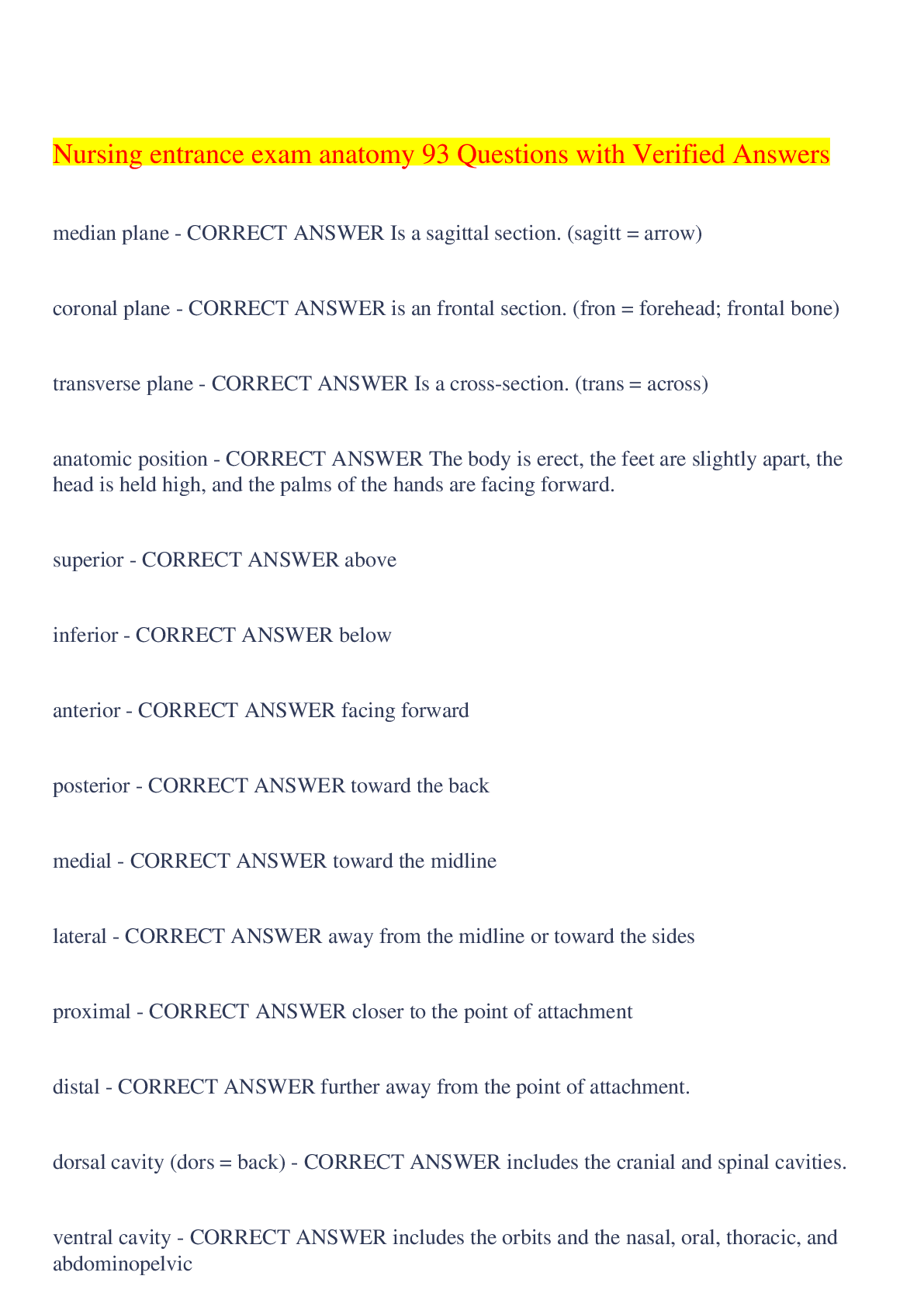
Reviews( 0 )
Document information
Connected school, study & course
About the document
Uploaded On
Dec 26, 2023
Number of pages
10
Written in
Additional information
This document has been written for:
Uploaded
Dec 26, 2023
Downloads
0
Views
41




